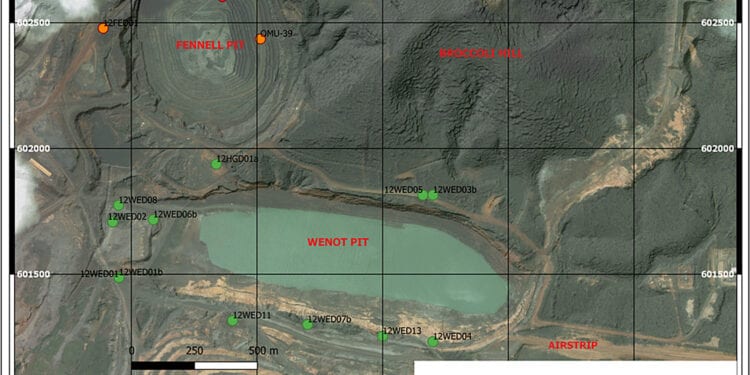Historic Results Extends Mineralisation Over 150m Below Historical Pit
Omai Gold Mines Corp. (TSXV:OMG) has achieved promising results from a programme of logging and sampling of 6,000m of unassayed core from a 2012 drilling programme that had been preserved by the Guyana Geology & Mines Commission (GGMC).
The company previously revealed that assays from the first two of these holes, 12WED11 and 12WED13, indicate that high-grade mineralisation extends below the Wenot Pit with additional expansion potential of gold mineralisation into the sedimentary units to the south. The new results from other holes confirm these conclusions.
Highlights of the assay results:
- All holes encountered high-grade gold associated with structural zones and felsic and dioritic dikes.
- The mineralisation extends 100 to 150m below the historical pit and remains open at depth.
- Holes drilled from the sediments towards the Wenot shear (northwards) all show significant and high-grade mineralisation:
Headline number from holes drilled towards the Wenot shear (northwards) all show significant and high-grade mineralisation including:
- Hole 12WED1B encountered zones of 7.4 meters of 3.2 grams per tonne (g/t) gold (Au) and 14.0 meters of 9.1 g/t Au in lithic wacke sedimentary rocks south of the Wenot Shear.
- Hole 12WED3B encountered 1.5 meters of 6.9 g/t Au and 2.5 meters of 6.3 g/t Au in the limited core available.
- Hole 12WED05 encountered multiple zones including 9.0 meters of 1.6 g/t Au, 3.0 meters of 7.7 g/t Au, 1.5 meters of 10.5 g/t Au and 9.5 meters of 1.6 g/t Au.
- Hole 12WED07B intersected 11.3 meters of 1.8 g/t Au and 3.5 meters of 4.1 g/t Au.
CEO, Mario Stifano, said the assay results from core that was drilled in 2012 and not previously sampled demonstrates that the Wenot grades and thicknesses from historical mining continue below the historical Wenot Pit.
“The results are important as not only has mineralisation been extended to depths of 100 to 150m below the pit and remains open to depth, but high-grade gold identified in the sediments has potential to widen the historical pit.
“We look forward to following up on these results with our planned 5,000m drill programme.”
These assayed holes have been incorporated in the historical drill hole database and review of historical logs to provide better understanding of controls on mineralisation for planning of the company’s initial drill programme.
Highlights include the section-by-section plotting of high-grade mineralisation associated with felsic and dioritic dikes along deformation zones.
Of particular note is the extension of mineralisation into the sedimentary package of lithic wacke south of the Wenot Shear zone.
Further drilling is part of the programme to expand the open-pit potential both within the sedimentary rocks and high-grade zones associated with felsic dikes below the Wenot historical mine.












